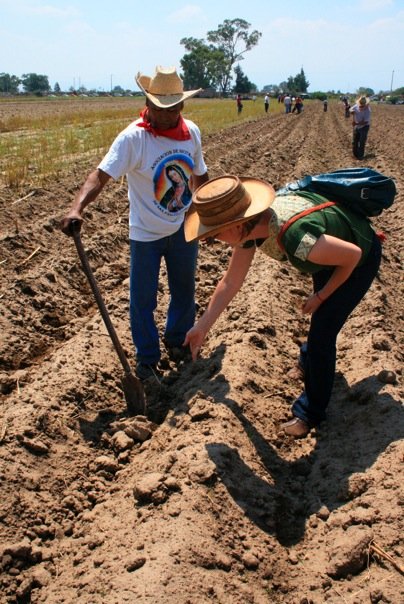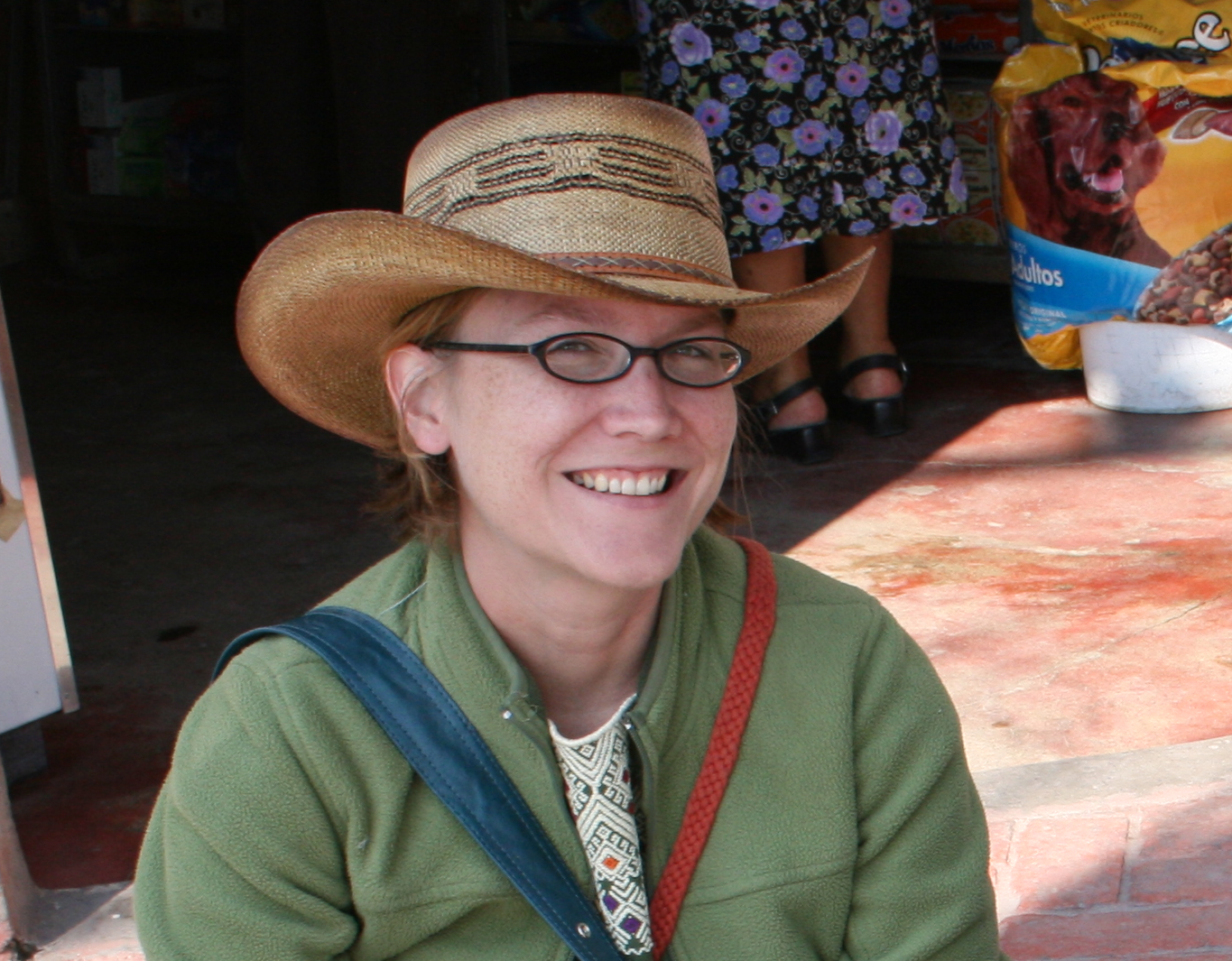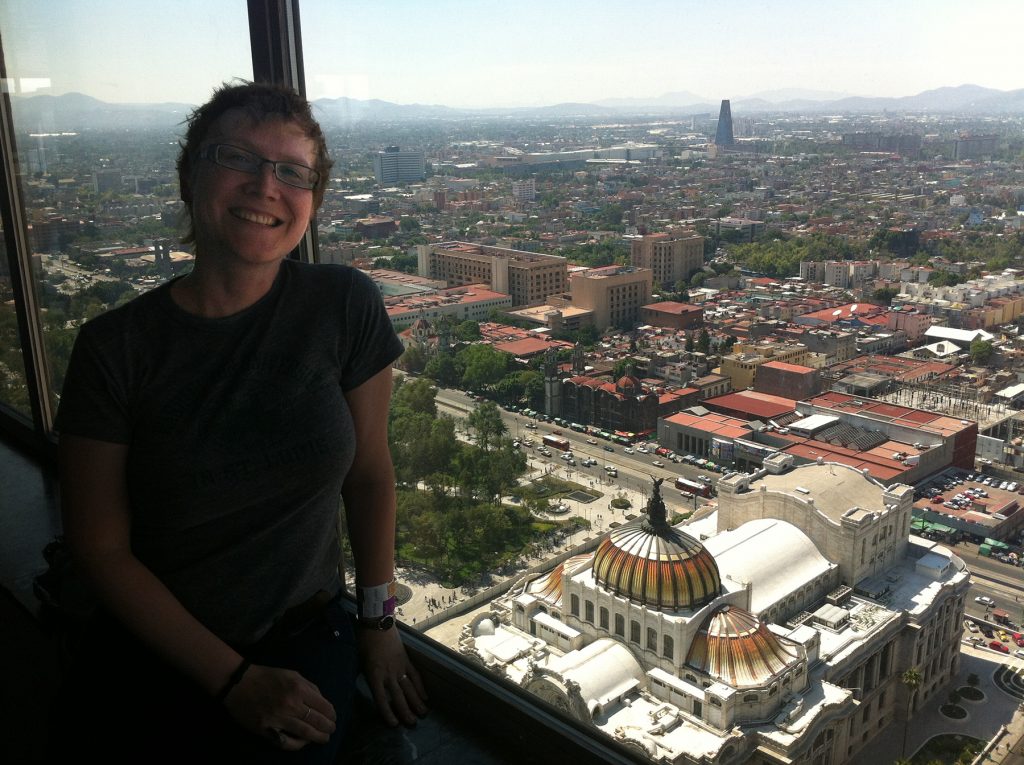
Liv Stone, right, was invited by an Atenco farmer to plant a few kernels of corn as the community gathered to plant the parcel of land of Ignacio Del Valle, a political prisoner. Photo by Lisa Roth.
A new book by Illinois State University’s Liv Stone sheds light on the ties forged between documentary films and social movements.
An assistant professor of anthropology, Stone has been studying the intersections between political activism, cultural change, and visual media for decades. She said even watching documentaries can be a form of protest. “People who might not feel strongly enough or be comfortable enough to show up for a march might come to a film screening,” she said. “It provides an opportunity to discuss and exchange ideas. It’s a way to get involved with a very low barrier for entry.”
In her new book, Atenco Lives! Filmmaking and Popular Struggle in Mexico, Stone examines how the production and sharing of documentaries became an important part of the story for the People’s Front in Defense of Land of Atenco (also known as the Frente). “The success of Frente was unprecedented among social movements in Mexico,” said Stone.
Filmmakers can take part in an ethical practice to engage people in a transformation of self.
— Liv Stone
A grassroots organization of farmers, the Frente successfully resisted the encroachment of a government airport project on communal farmland in the early 2000s. Even after the victory, the Frente remained a strong force in politics until a government crackdown in 2006. Seeking to quash the influence of the Frente over the 13 villages that comprise Atenco, more than 3,000 police in riot gear stormed the area in a brutal incursion that included intimidation, mass arrests, violence on a wide scale, and rape of women who were taken into police custody.
At the time of the crackdown, Mexico City media often defended the crackdown. “Journalists were narrating the story in such a way that it justified the human rights abuses,” said Stone, who said images usually portrayed the Atenco residents with machetes, which was a symbol of the farmers of Frente. “What followed was an explosion of independent media in response to that repression. And that became a larger part of the story of Atenco.”
 Documentaries exposed the brutalities of the crackdown in Atenco. The sharing of those films provided another form of activism, said Stone. “We think of YouTube as all-encompassing now, but even 20 years ago people were burning documentaries onto CDs, and handing them to each other,” said Stone. The exchange and viewing of the documentaries fostered support and created connections vital to bringing attention to Atenco. “The book talks about the process of production and circulation being an important activist practice,” said Stone.
Documentaries exposed the brutalities of the crackdown in Atenco. The sharing of those films provided another form of activism, said Stone. “We think of YouTube as all-encompassing now, but even 20 years ago people were burning documentaries onto CDs, and handing them to each other,” said Stone. The exchange and viewing of the documentaries fostered support and created connections vital to bringing attention to Atenco. “The book talks about the process of production and circulation being an important activist practice,” said Stone.
In the book, Stone profiles some of the most influential documentaries, including a chapter dedicated to Breaking the Siege, or Romper el Cerco, by the film studio Canalseisdejulio. Working at this studio in Mexico in 2006, filmmaker Mario Viveros at Canalseisdejulio knew little about Frente. “He was vaguely sympathetic to Atenco, but not very involved in the politics,” said Stone, who spoke at length with Viveros for the book. The arrest and deportation of a Chilean film student Viveros knew drew his attention to the crackdown. “This person was arrested. And—as a woman—she was assaulted when she was arrested. That’s part of the film,” said Stone. Romper el Cerco became an international phenomenon, viewed on simultaneous projections in Brazil, Mexico, and New York City in 2009, pulling in even more attention to Frente.
The interest of filmmakers spread worldwide. “While I was there, small collectives of young people came to make documentaries—activists from France, the United States, South America,” said Stone, who lived and worked in the Atenco area while she conducted interviews and research on the group in 2009. “They were attracted to creating solidarity with Frente.” While not all of those activists’ films were finished, Stone noted the connections made were vital to carrying on the story of Atenco.
Stone spoke with many in the movement, and accompanied them to marches and press conferences. “I felt like it was part of my job as an anthropologist to go to political events,” she said. Though she was not taking part in the activities, if Stone had been pulled in during a police roundup of protestors, she could have been deported and banned from returning for five years. “When I would go to political events, I never chanted slogans, I never held a machete, I never did what I thought was participating as an activist in the event,” added Stone.
Stone hopes the book adds to the discussion of not only Atenco, but of how people interact with social movements. “Filmmakers can take part in an ethical practice to engage people in a transformation of self,” said Stone. “Seeing a documentary can alter both how you think of yourself as a political subject, and how you think of yourself as an ethical subject.”
Learning and Scholarship is a University core value, stated in Educate Connect Elevate: Illinois State—The Strategic Plan for Illinois’ First Public University 2018-2023.


